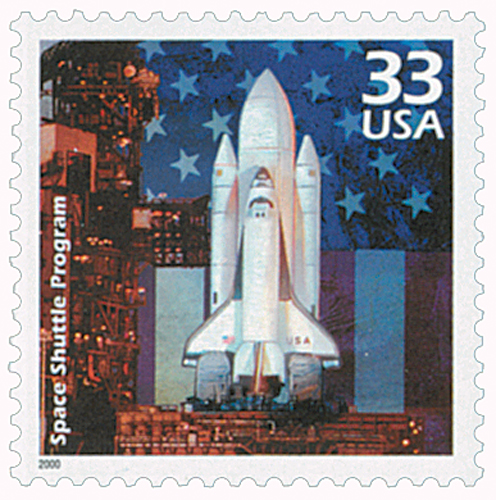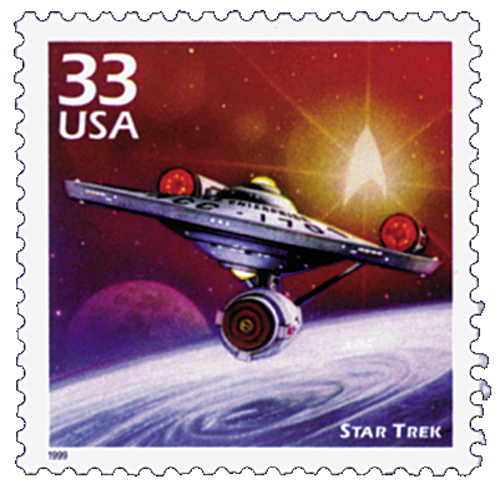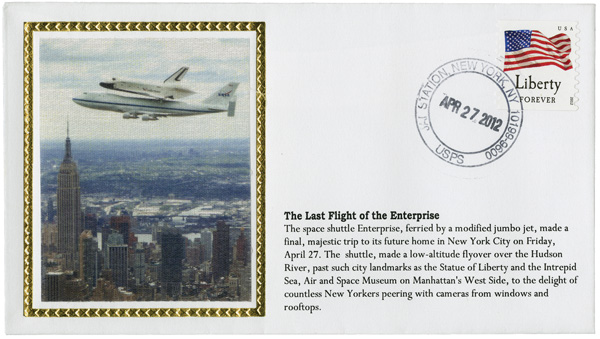
# 5132-35 - 2016 First-Class Forever Stamp - Star Trek
In 1964, writer and producer Gene Roddenberry had an idea for a new science fiction show. It combined the action of a Western with the adventure of space. He called it a “wagon train to the stars,” which nearly became the name of the show.
Inspired by the Horatio Hornblower novels and Gulliver’s Travels, Roddenberry envisioned Star Trek as more than just science fiction. He believed it was an example of what humanity could become if it learned from its past mistakes and put an end to violence.
Premiering on September 8, 1966, Star Trek was ahead of its time. In the midst of the Civil Rights Movement and tensions with communist nations, the multi-racial cast included African Americans, Asians, and Soviets – which was unheard of at the time. Though set in space and on alien planets, the storylines directly reflected events of the time – war and peace, imperialism, class warfare, and human rights.
Star Trek also introduced seemingly impossible technologies. Some became reality – cell phones and tablet computers – while others have not.
Though the original Star Trek lasted just three seasons, renewed interest over the years sparked five additional series, 13 movies, comics, games, books, and more. This ensures there will be new generations of Star Trek fans, or “Trekkies,” for years to come.
Printed by: Ashton Potter
Method: Offset
Self-Adhesive
NASA Unveils Enterprise

On September 17, 1976, America’s first space shuttle, the Enterprise, made its debut public appearance.
In the 1960s and early 1970s, NASA and the Air Force researched different ways of flying winged vehicles back from space and landing them similar to an aircraft. From this research they built six different prototypes and flew 223 glide tests that would help them to develop the concept of the first space shuttle.

Plans for America’s first two shuttles were approved and contracts awarded on July 26, 1972. One shuttle would be a test ship built without engines or a heat shield, making it incapable of spaceflight, while the other, the Columbia, would be the first shuttle to make it into space.

Initially, the test ship, designated OV-101, was to be named Constitution, and presented to the public on Constitution Day, September 17, 1976. However, fans of the television show Star Trek launched a massive letter-writing campaign requesting that the shuttle be named after the starship from that show, the Enterprise. President Gerald Ford received hundreds of thousands of letters, and was also partial to the name, so he encouraged NASA to change it.
After the shuttle was completed, it was ready to be unveiled publicly. The rollout was still held on September 17, 1976, in Palmdale, California. However, because of the connection to Star Trek, series creator Gene Roddenberry and several cast members were invited to take part in the dedication ceremony. Click here for a photo from the ceremony.
The following year, the Enterprise began a series of flight tests that would prove invaluable to the future shuttle program. Most of these tests revolved around approach and landing. These tests proved that the shuttle could fly in the atmosphere and land like a plane even though it didn’t have power, similar to a glider. The Enterprise was also subjected to vertical ground vibration tests.

Initially, NASA planned to refit the Enterprise so it could be used in space, but they found it would be too costly. Instead, the Enterprise was retired and sent to the Smithsonian in Washington, D.C. It was later sent to New York as part of the Intrepid Sea, Air & Space Museum.
Click here for photos of the Enterprise.
In 1964, writer and producer Gene Roddenberry had an idea for a new science fiction show. It combined the action of a Western with the adventure of space. He called it a “wagon train to the stars,” which nearly became the name of the show.
Inspired by the Horatio Hornblower novels and Gulliver’s Travels, Roddenberry envisioned Star Trek as more than just science fiction. He believed it was an example of what humanity could become if it learned from its past mistakes and put an end to violence.
Premiering on September 8, 1966, Star Trek was ahead of its time. In the midst of the Civil Rights Movement and tensions with communist nations, the multi-racial cast included African Americans, Asians, and Soviets – which was unheard of at the time. Though set in space and on alien planets, the storylines directly reflected events of the time – war and peace, imperialism, class warfare, and human rights.
Star Trek also introduced seemingly impossible technologies. Some became reality – cell phones and tablet computers – while others have not.
Though the original Star Trek lasted just three seasons, renewed interest over the years sparked five additional series, 13 movies, comics, games, books, and more. This ensures there will be new generations of Star Trek fans, or “Trekkies,” for years to come.
Printed by: Ashton Potter
Method: Offset
Self-Adhesive
NASA Unveils Enterprise

On September 17, 1976, America’s first space shuttle, the Enterprise, made its debut public appearance.
In the 1960s and early 1970s, NASA and the Air Force researched different ways of flying winged vehicles back from space and landing them similar to an aircraft. From this research they built six different prototypes and flew 223 glide tests that would help them to develop the concept of the first space shuttle.

Plans for America’s first two shuttles were approved and contracts awarded on July 26, 1972. One shuttle would be a test ship built without engines or a heat shield, making it incapable of spaceflight, while the other, the Columbia, would be the first shuttle to make it into space.

Initially, the test ship, designated OV-101, was to be named Constitution, and presented to the public on Constitution Day, September 17, 1976. However, fans of the television show Star Trek launched a massive letter-writing campaign requesting that the shuttle be named after the starship from that show, the Enterprise. President Gerald Ford received hundreds of thousands of letters, and was also partial to the name, so he encouraged NASA to change it.
After the shuttle was completed, it was ready to be unveiled publicly. The rollout was still held on September 17, 1976, in Palmdale, California. However, because of the connection to Star Trek, series creator Gene Roddenberry and several cast members were invited to take part in the dedication ceremony. Click here for a photo from the ceremony.
The following year, the Enterprise began a series of flight tests that would prove invaluable to the future shuttle program. Most of these tests revolved around approach and landing. These tests proved that the shuttle could fly in the atmosphere and land like a plane even though it didn’t have power, similar to a glider. The Enterprise was also subjected to vertical ground vibration tests.

Initially, NASA planned to refit the Enterprise so it could be used in space, but they found it would be too costly. Instead, the Enterprise was retired and sent to the Smithsonian in Washington, D.C. It was later sent to New York as part of the Intrepid Sea, Air & Space Museum.
Click here for photos of the Enterprise.













